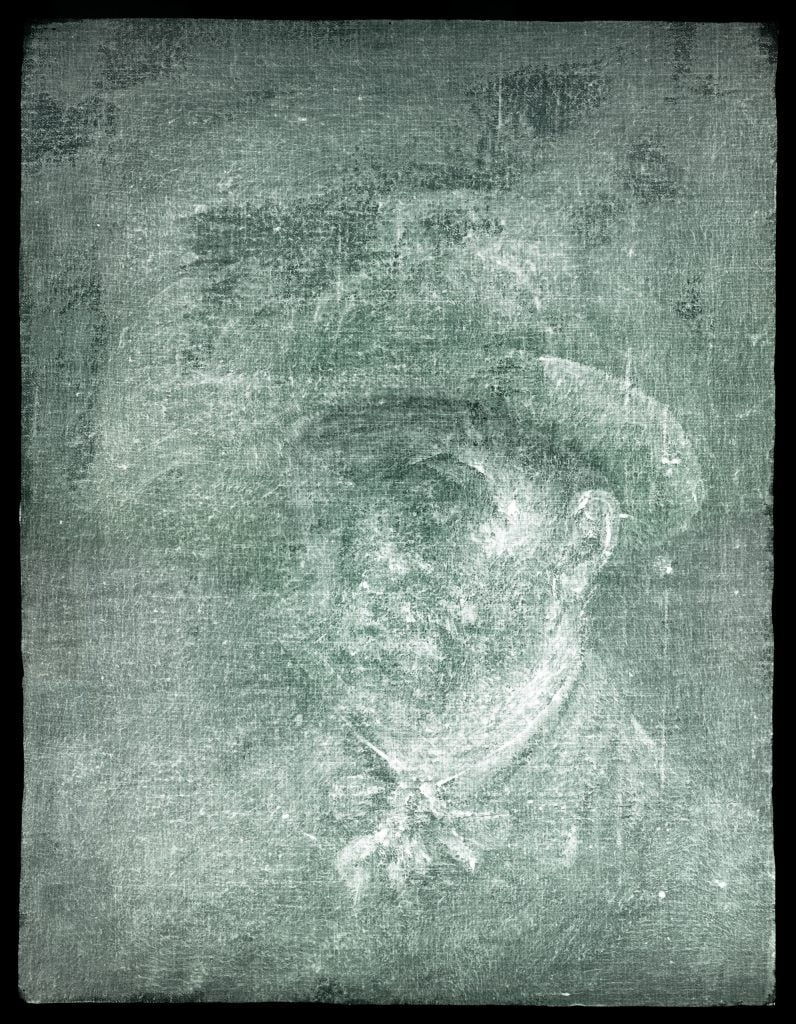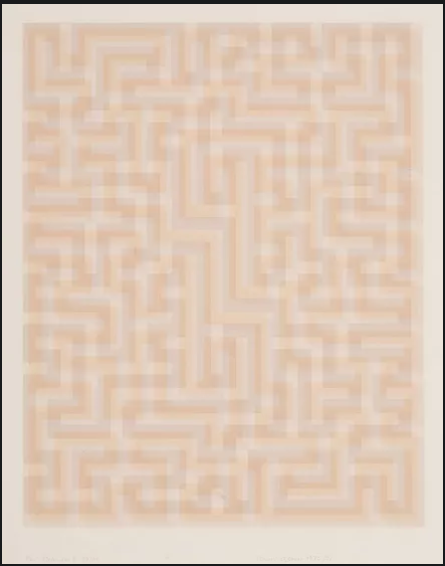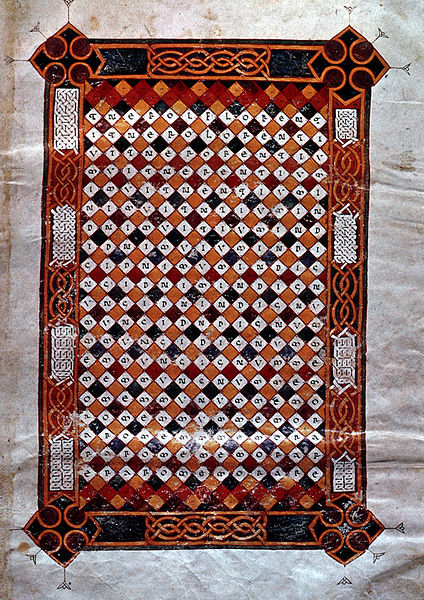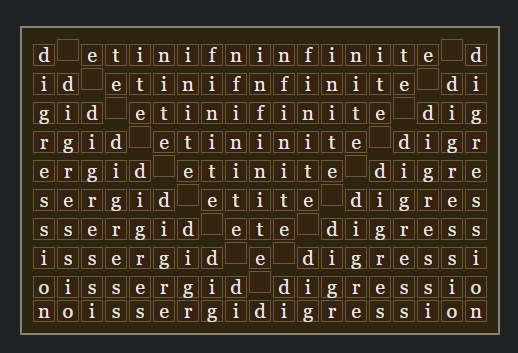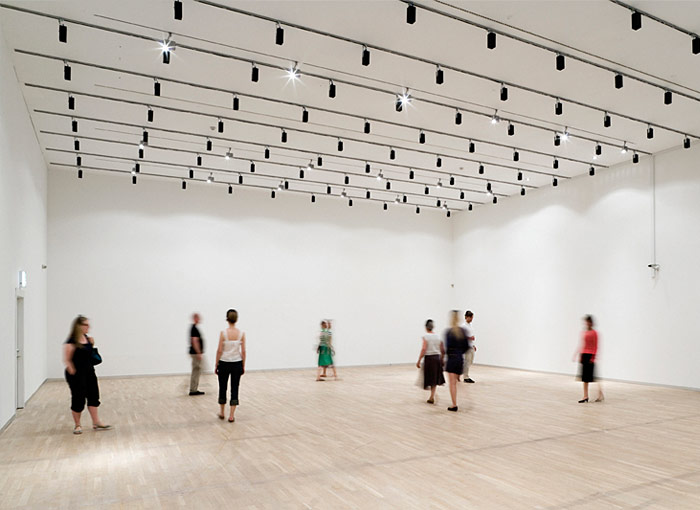created 2025-01-01, & modified, =this.modified
tags:lostaggregator
Thought
Collecting varying instances of “being lost” or the concept of “lost” as a new avenue of research.
The motivation here is a continuation of studying Alterity or strangers/strangeness and the different forms being lost take. For example, someone will be in your life at one point in time and then you lose them. You might not even notice this.
Also items like this, “I lost my love” “I thought I had lost you”
Yes, I feel lost but it isn’t necessarily a negative emotion to me (in the sense I am just waiting for the resolve of being found or returning to some flock). I like to feel somewhat lost. But at the same time, I do have a fear of losing certain others. But none of these ultimately distress me currently. It’s just the state of things and that is it.
Similar studies to other “aggregators” like Survey of Shadows Survey of Sirens Survey Of Shadows Continued Survey of Running the Bases Survey of Computer Expert As Wizard Archetype Islands River and Death
Questions and Miscellaneous
The word lost originates from the Old English losian, meaning to perish.
We’ve attempted to minimize the feeling of being lost. A GPS will guide us, but at the heart of that action often is being truly lost and just having an object to guide you. It feels you are just lost, but only now listening.
Games we play will highlight that path which we should take. The solution of where you want to go is only a button press away.
Overall, this is good.
But what of an experience that caters to being lost as something that is ok?
Vague questions
- What is the proportion of things we lose to things we keep?
- Could things be stolen from you and not noticed gone? Books you own. Your favorite things.
- How do you lose something?
- What is the oldest thing found?
- Why are we attracted to mazes?
- What is missing something?
- Is it possible to not be lost?
You can be lost by being left behind, but you can also be lost by going too far.
When you’ve Lost Something physical the search and behavior of the person becomes very different. It’s obvious something was lost. This behavior is also different than someone being lost. Steps to find something often involve retracing steps, deep reflection of events and precise visual inspection. In contrast one guide I saw mentions “give up” as means of eventually finding something you’ve lost.
Interacting with any object is initially met with a moment of loss. If I am looking for my keys, even if I know they are on the hook, are they momentarily lost till I confirm and hold them in my hands? If so, the present has these foam of loss where things are lost and immediately found and other things, through neglect or otherwise end up sinking towards the depths.
“I never was lost in the woods in my whole life,” said Daniel Boone, “though once I was confused for three days.”
Saying “Get Lost” to someone. Is there a relationship to the ban here? Excommunication.
Lost Literary Works and Media
Many early films are lost. Knowledge of them exist exist through things like reviews from the time.
There is something tantalizing to something surviving only in fragments as well. Something that no longer exists, can be anything, but something that is a fragment grounds it.
Ancient works won’t even have surviving names. The names sometimes are the only fragments that exist., pointing to an empty space.
Van Gogh Self Portrait and Underpaintings
The state of lostness to a painting that lies beneath another painting? relBug on Sensor
In 2022,
Conservators carrying out a routine x-ray on Van Gogh’s Head of a Peasant Woman (1885) believe they may have discovered the Post-Impressionist’s first ever self-portrait.
Many examples of this style of discovery exist.
Portrait of Amedeo Modigliani’s ex-lover Beatrice Hastings

Amedeo Modigliani may have had reasons for covering his tracks when painting over old pictures. Another woman has been found beneath his Portrait of a Girl (1917), in a portrait that is almost full length and visible with impressive clarity. She is believed to be the artist’s former lover Beatrice Hastings, with whom he had a messy breakup around 1916, offering a solid possible motive for reusing the canvas.
Nurikabe
rel: The Book of Japanese Folklore - Thersa Matsuura

The Nurikabe (“plaster wall”) is a type of yokai that resembles a large wall with varying amounts of anthropomorphic elements. It may have legs, hands, and facial features; sometimes it looks somewhat like a flattened elephant with three eyes.
Some accounts say it extends forever, and trying to go around the wall is futile.
Nighttime travelers are the primary targets of the nurikabe. It appears without warning, blocking further movement, and any attempts to bypass it are futile. Sometimes it impedes without materializing, slowing travelers down as though they were slogging through tar.
Nurikabe will disappear if struck at the base with a stick, but doing so to the upper part of the wall has no effect.
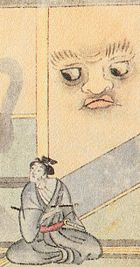
Tanuki Origin
According to the legend, Tanuki (raccoon dogs) enlarge their testicles and form a wall in front of night walkers, preventing people who encounter them from seeing in front of them.
Irrwurz
Stray Stod and Irrwurz
created,
=this.created& modified,=this.modifiedtags:y2025lost rel: Survey of Being Lost
There are various plants that induce befuddlements or getting lost.
The German-speaking legendary plant has various identities. Some view the origin as a tree root, growing crosswise or belonging to a tree hit by lightning.
Whoever steps on the Irrwurz goes astray and cannot find the way back. Sometimes you are transferred to a knacker’s yard, or a swap.
Herbe d’égarement in France (herb which leads astray). In Burgundy, whoever steps on the so-called tourmentine growing in the forest will walk the same path a hundred times over without being able to recognize it lest he finds the herb Paris whose seeds show where the path continues when they fall.
Stray Sod
In contemporary fantasy literature the concept of a stray sod is a clump of grass enchanted by faeries.
If you step on one, you become disoriented or lost, even in familiar surroundings. The only way to break out is wearing clothing inside-out.
Link to original
Maze Mall
Maze Mall
created,
$=dv.current().file.ctime& modified,=this.modifiedtags:mazelostconceptThought
I was just wondering if transclusion was possible in Obsidian. It does appear to be so! Game changing foraggregator and Surveys.
Motivating topics: Gruen Transfer, Mazes and Labyrinths - Their History and Development by Matthews Survey of Being Lost
As a store owner what rules exist that wouldn’t allow you to trap your shoppers in a maze-like consumer environment? It seems like if you were a complete madman, you could maximize the maze-like quality of a shopping experience. People would stop shopping there, “I’ve stopped shopping at Maze-mart because last time I was truly afraid. I went in to get eggs and was lost for hours.”
The aisle structure of the modern supermarket does have a geometric maze-like quality. If you as an owner were to shift around various shelves so that they didn’t just form parallel lines but cut off routes and lead to dead ends, you can easily adapt this style into a maze.
The most devious way might target a single shopper in a maze. The aisles would morph around this shopper.
I’ve been in Ikea numerous times in my life, and each one has a degree of disorientation and maze-like quality to it. I recall directional arrows on the floor. The various artificial domestic settings also contributes to a strange atmosphere when lost, like some scattered familiarity.
Link to original
Properties of Mazes
Mazes can be transformed into straight line diagrams (traversal of a path)
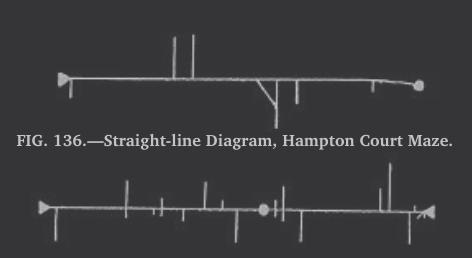
You may place marks, or place one hand on the hedge and following that hedge around. “The traveller being guided by his contact with the hedge alone is relieved of all necessity for making a choice of paths when arriving at the nodes.”
The only case in which this method breaks down is that in which the goal is situated anywhere within a loop. Where this occurs the explorer adopting the method described will discover the fact by finding himself eventually back at the starting point without having visited the goal.
Dual Graph
If you solve the maze by “walking on the lines” and there is an uninterrupted path across, it is a way of telling if the maze is unsolvable. An impenetrable wall divides the problem with the solution.
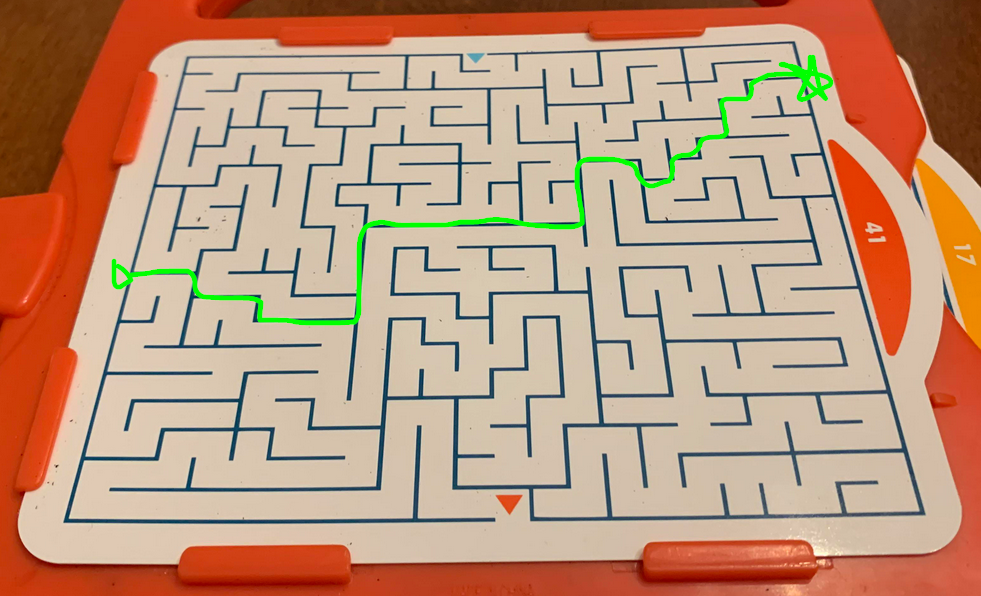
(If you flood fill a section it reminds me of a type of classification)
Single Line Mazes
 Architect Wacław Szpakowski produced single line, continuous mazes.
Architect Wacław Szpakowski produced single line, continuous mazes.
The drawings, he explains, “were experiments with the straight line conducted not in research laboratories but produced spontaneously at various places and random moments since all that was needed to make them was a piece of paper and a pencil.” Though the kernels of his ideas came from informal notebooks, the imposing virtuosity and opaqueness of Szpakowski’s final drawings are anything but spontaneous or random. His enigmatic process — how he could draw with such supreme evenhandedness, could make his designs so pristine and yet so intricate — is hinted at only in his few visible erasure marks.
Kim Beom (Intimate Suffering)
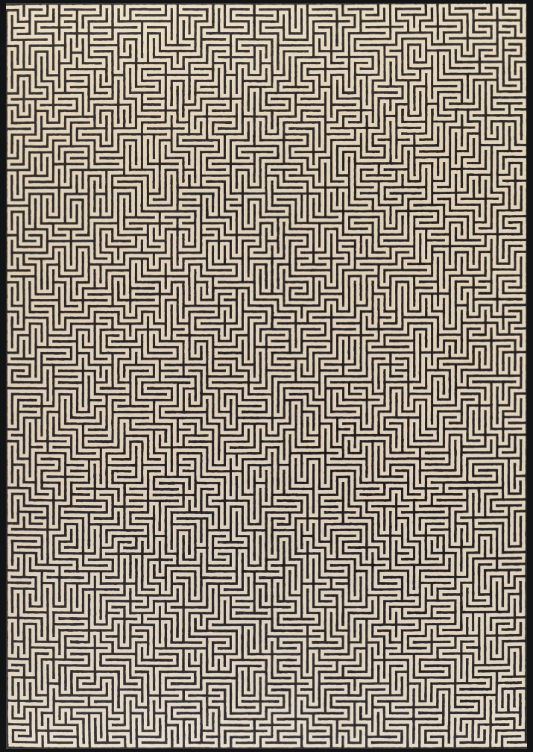
Kim Beom creates a visual riddle by mapping a massive network of lines that zigzag across a ten-by-seven foot canvas. In laboring over such an absurd task, Kim interrogates the idea of art as a leisure activity. At the same time, the viewer is challenged to solve this colossal labyrinth—certainly a visual endurance test. As Kim notes, “Life comes with its share of problems, and solving problems and finding the right way is hard, but it seems to be human instinct and nature to do so.”
Meanders by Annie Albers
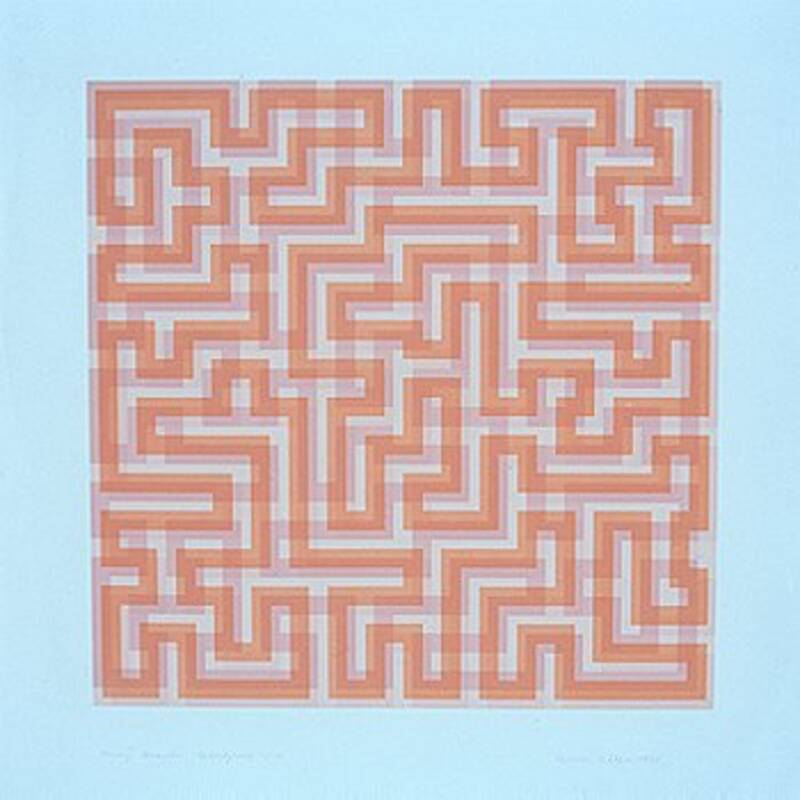
This particular print went through the press four times. First, she laid down the background as a solid colour. And then, using the same colour, she ran the print through the press two more times, using a cut design screen that was half an inch smaller than the background, so that she could first align it with the top left corner, and then align it with the bottom right corner. And this second time, she also turned the screen upside down. This meant that the pattern would be inverted and off-register; wherever it overlapped, it created a slightly darker, ghost-like tone that was only minimally perceptible.
Lost Labyrinths
Labyrinths are described in medieval manuscripts as being “lost” in Herman Kern’s 1984 Labyrinthe catalog of them. In the digital world, many have been located and placed online.
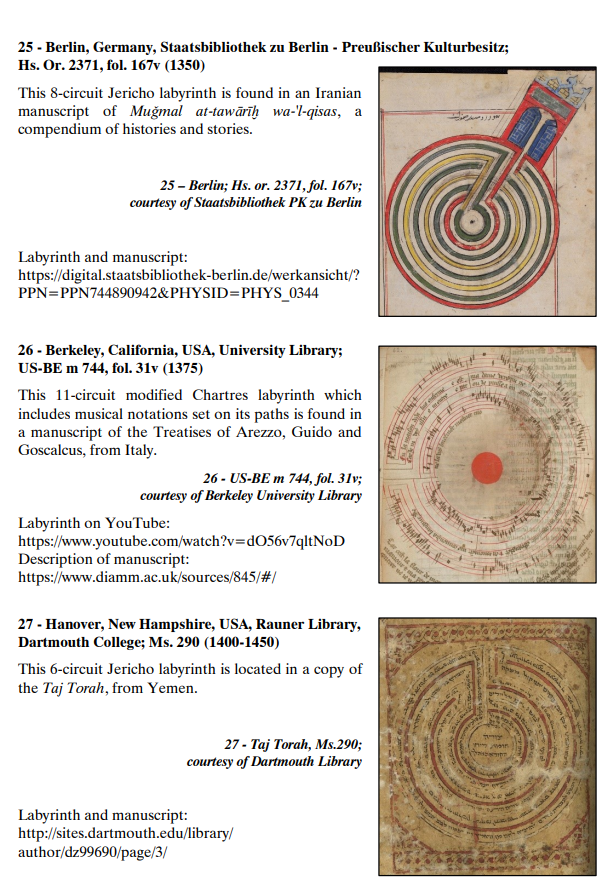
Florentius Labyrinth
rel:Wild Geese Returning - Chinese Reversible Poems by Michele Metail Oulipo “FLORENTIUM INDIGNUM MEMORARE” is inscribed over and over, “Remember Unworthy Florentius”Thought
I find a builder, online, from the text where this is done in code. I put infinite digression in there.
Florentius cautions the readers to not use their fingers to trace. The prayer, in this grid of 260 letters repeats the phrase 354, 200 times.
Link to originalNo mortal unassisted by a counting machine could possibly arrive at this total. But what is likely is that a monastic user trained by lectio divina to think of reading less as pageturning forward movement than as a recursive, repetitive exploration would have come to feel that the labyrinth’s apparently infinite permutations made it an inexhaustible, nearmiraculous generator of prayer. Florentius’s shuttling prayer can lead the attentive user of this page into something very like meditatio
Lethe
Lethe and Mnemosyne
created,
=this.created& modified,=this.modifiedtags:rivers rel: River and Death Survey of Being LostOne of the rivers of the underworld of Hades. Also known as the river of unmindfulness.
Lethe flowed around the cave of Hypnos and through the underworld where all those who drank from it experienced complete forgetfulness. The river was often associated with Lethe, the personification of forgetfulness and oblivion, who was the daughter of Eris (strife.)
In classical Greek lethe literally means forgetting or forgetfulness.
The shades of death were required to drink the waters of Lethe in order to forget their earthly life. Only once the dead have lost their memories can they be reincarnated.
An Orphic inscription warns readers to avoid Lethe and seek Mnemosyne instead. Their thirst will not be quenched in Lethe, causing them to drink more than necessary.
A few mystery religions taught the existence of another river, the Mnemosyne; those who drank from the Mnemosyne would remember everything and attain omniscience. Initiates were taught that they would receive a choice of rivers to drink from after death, and to drink from Mnemosyne instead of Lethe.
Mnemosyne
Mnemosyne presided over a pool in Hades, a counterpart to Lethe.
Link to original
Flâneur
From Charles Baudelaire:
The concept of the flâneur, originating from the French word for ‘strolling’ or ‘loafing,’ emerged in mid-nineteenth-century Paris and later extended to other European cities, particularly Berlin. A flâneur was primarily a leisurely observer of city life, someone who wandered through urban landscapes, observing but not actively participating in what they witnessed. This allowed them to experience and analyse city existence from a detached, external perspective.
Baudelaire was influenced by Edgar Allan Poe’s “The Man of the Crowd”
The tale opens by saying that it is “a great misfortune, not to be able to be alone.” The narrator in “Man of the Crowd” is surrounded by a city full of people, unable to be alone, though is truly isolated from them. Through the observations made by this narrator, it is evident that the same isolation applies to every other member of society in London; no one knows anyone else and, in that sense, everyone is isolated. Though, these people are not alone in that none of them are distinguishable from a larger group. Each person is defined as being part of a group within the crowd and as a part of the crowd generally. It is this loss of individuality that gives meaning to the vagueness title “The Man in the Crowd.”
The man of the crowd is the nameless individual, generated and lost by virtue of the existence of a crowd.
A Field Guide to Being Lost by Rebecca Solnit
created, 2025-02-05 & modified,
=this.modifiedrel: Survey of Being Lost
Why I'm reading
“How will you go about finding that thing the nature of which is totally unknown to you?
Artists, and Scientists too, as J. Robert Oppenheimer once remarked, “live always at the ‘edge of mystery’—the boundary of the unknown.”
“Not to find one’s way in a city may well be uninteresting and banal. It requires ignorance — nothing more. But to lose oneself in a city - as one loses oneself in a forest - that calls for quite a different schooling.” - Walter Benjamin
To lose yourself: a voluptuous surrender, lost in your arms, lost to the world, utterly immersed in what is present so that its surroundings fade away.
Literal Lost
There’s an art of attending to weather, to the route you take, to the landmarks along the way, to how if you turn around you can see how different the journey back looks from the journey out, to reading the sun and moon and stars to orient yourself, to the direction of running water, to the thousand things that make the wild a text that can be read by the literate. The lost are often illiterate in this language that is the language of the earth itself, or don’t stop to read it.
Early explorers were always lost, because they were in completely unfamiliar places that nobody had been before. They never expected to know exactly where they were, but they knew their instruments well and had an sense of optimism about surviving and finding their way.
Lost is the familiar falling away, and the unfamiliar appearing. Getting lost is the case where the world has become larger than your knowledge of it.
Lost, Distant Blue
The world is blue at its edges and in its depths. This blue is the light that got lost. Light at the blue end of the spectrum does not travel the whole distance from the sun to us. It disperses among the molecules of the air, it scatters in water. Water is colorless, shallow water appears to be the color of whatever lies underneath it, but deep water is full of this scattered light, the purer the water the deeper the blue. The sky is blue for the same reason, but the blue at the horizon, the blue of land that seems to be dissolving into the sky, is a deeper, dreamier, melancholy blue, the blue at the farthest reaches of the places where you see for miles, the blue of distance. This light that does not touch us, does not travel the whole distance, the light that gets lost, gives us the beauty of the world, so much of which is in the color blue.
Distant blue, beautiful, and never possessed.
Shul
Tibetan concept, shul, which is a mark that remains after that which made it has passed by i.e. a footprint, a channel worn through rock, indentation in the grass. The impression that something once was there.
Mourning Wars
Iroquois engaged in a practice called Mourning Wars which was vengeance for those lost. Occasionally captives were assimilated into the tribe as a direct replacement for the one lost.
Individuals taken would often be placed into the role of the individual they were supposed to replace. A young man replacing a fallen warrior, (if assimilated) would take his place and be considered the new son of the fallen man’s mother, take any wives the fallen man had had, etc. A woman captured to replace a fallen woman would take her spot just as closely, becoming the new wife of whomever had lost theirs.
The main factor in determining if a family would adopt or execute a captive was the the proximity of their grief. If the death that prompted their participation in the Mourning War was recent or sudden, their captive would likely meet an untimely end; if the family’s grief had some time to abate naturally, then they’d usually be more willing to adopt the captive.
The adoptee became the deceased’s heir, inheriting their name and perhaps their social privileges if they were found to be deserving of such ranks.
Ruin
A city is built to resemble a conscious mind, a network that can calculate, administrate, manufacture. Ruins become the unconscious of a city, its memory, unknown, darkness, lost lands, and in this truly bring it to life. With ruins a city springs free of its plans into something as intricate as life, something that can be explored but perhaps not mapped.
An urban ruin is a place that has fallen outside the economic life of the city, and it is in some way an ideal home for the art that also falls outside the ordinary production and consumption of the city.
Terra Incognita
Borges’ parable The Parable of the Palace by Borges speaks to how knowledge is an Islands surrounded by the oceans of the unknown. They signify that the cartographers knew that they did not know, and awareness of ignorance is not just ignorance; it is awareness of knowledge’s limited.
A Roman named Crates made a globe based on the theory that the earth had four continents, three of them unknown. He abandoned the idea of a world encompassed by water, of a circumfluent ‘oceanus’ relatively close by. Before Crates, maps depicted a known world surrounded by water.
Link to original
Praxilla
In reading about Praxilla, what remains of her poems are only fragments. A fragment is a piece of something and here we can only read what remains. The rest is lost.
Praxilla’s famous poetic fragment about Adonis (Hymn to Adonis), has Adonis in the Underworld speaking of what he misses from the mortal realm:
“Finest of all the things I have left is the light of the sun, Next to that the brilliant stars and the face of the moon, Cucumbers in their season, too, and apples and pears.”
She, and the notion, are considered simpletons by Zenobius.
Zenobius condemns Adonis’ response, saying, “anyone who lists cucumbers and the rest alongside sun and moon can only be regarded as feeble-minded”.
Record of this fragment, exists because of this record from Zenobius.
Thought
On the modern appraisal of Praxilla, you can be lost in your own time but found in another.
Further lost, Praxilla’s “female identity complicates her poetic reception.” She was a female writer who was writing drinking songs. Some attribute the material to another poet, Alcaeus or Sappho, where she is deprived of authorship.
Micromouse
Micromouse
created 2025-14-02, & modified,
=this.modifiedThe micromouse competition is a an event where participants craft small autonomous electronic mice to solve a 16x16 grid maze.
In 1977 IEEE Spectrum introduced the concept of the micromouse and two years later the first competition was held. The winner at this time is described as a high speed, dumb wall follower.
The modern format involves a run where the the mouse must reach the goal unaided. It keeps track of the walls and where it is, and detects reaching the goal. Then they attempt to reach the optimal route in the quickest time.
Recent advancements are equipping the mice with a fan to “produce a partial vacuum under the mouse while it is running.” Straight line accelerations can exceed 2.5g.
They have typically used traditional maze solving algorithms to compete, such as Dijkstra’s, A*, and various graph or tree traversal algorithms.
Link to original
Maze Generation
“If the subgraph is not connected, there are regions of a graph that are wasted because they do not contribute to the search space.”
This intrigues me because you are getting multiple independent universes. But I am thinking of ways that an unconnected graph can affect the solving of a maze. Even though they are not part of the search space (in an autonomous method) increased visual complexity can be confounding.
Speaking of confounding elements, loops can be challenging for naïve solvers.
Invisible Labyrinth and Semi Circular Space
In this work by Jeppe Hein:
The work is an imaginary labyrinth without physical walls directing the movement of the visitors. Instead, the maze structure is organized by infrared signals. In a big space, a fixed number of infrared emitters are mounted to the ceiling at equal distance to each other, forming a grid pattern. Each emitter can be switched on and off separately via a control board, allowing the creation of a new maze structure every day. At the entrance, the visitor finds a board with printed diagrams of the different pre-programmed labyrinths performed on different days during the week, and attached infrared sensor headsets, which react with a vibrating alarm when an infrared signal, equivalent to an invisible wall, is received. The visitor thus combines the visual information with the technologically produced invisible leads, recreating the labyrinth in his imagination. The invisible labyrinth is a new form of architecture or sculpture, since it is no longer a visible or physical tangible object, but a work of the imagination and thus only becomes a sculpture through the interactivity and psychology of the viewer.
Semi-circular Space is a Labyrinth of mirrors

Salvatore Garau
Presented an “immaterial sculpture” consisting of nothing at all entitled “lo sono (I am)” which was sold for £12,000 net of commission and expenses. The purchaser received a certificate of authentication.
Similarly, “Buddha in Contemplazione” (Buddha in Contemplation) which was an invisible, intangible sculpture.
“It is a work that asks you to activate the power of the imagination”
Thought
Can you affix this sculpture to someone you love? Does it take on who they are if they put their face into the space where it stands (and you love them)? Can they never remove it? Never escape it?
Aphrodite Crying:
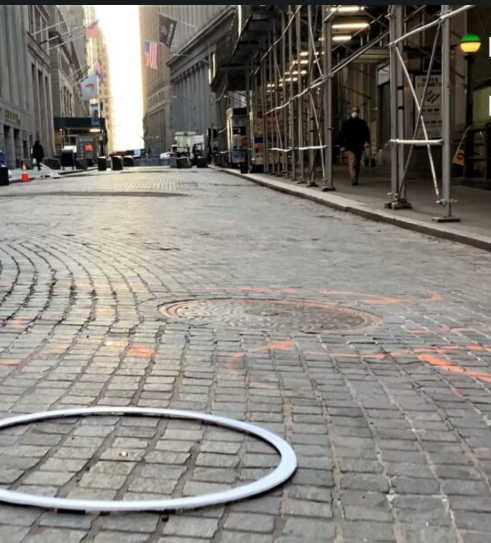
Not a sculpture made of marble, stone or iron but one made of absence, the material that has dominated the planet in these years and that Garau has transformed into something tangible, since he has come to see absence as a presence, almost a sculptural one, which must be born freely in the minds of each one of us.
Infinite Sculptural Spaceconcept
Thought
These artists should not focus on an area. They should place invisible sculptures, say of angels (how many dance on the head of a pin?), on every available space on the earth. For just that instant where time has stopped, every single space that isn’t human filled - for example the distance from this text to your eyes, is filled with invisible angel sculptures.
Or, you leave a trail of invisible sculptures of you in your wake while you walk.
Map Piece by Yoko Ono
Map Piece was Yoko’s contribution to the MoMA “Information” exhibit in 1970:
Draw an imaginary map. Put a goal mark on the map where you want to go. Go walking on an actual street according to your map.
Prior to this there are two related works:


Stanley Brouwn “This Way Brouwn”
Stanley Brouwn asked passerbys to draw directions to a particular location which he compiled.
What he did was to ask someone, “How can I get from here to another point of the city?” And he would hand them a sheet of paper, with a pen or a pencil. And, the passerby was asked to make the drawing. And what Stanley Brouwn did was to ask similar directions to different people. So on one side, you see someone who is telling him with very geometrical line how to cross the city, and someone has a much more smooth, fluid way of crossing the city.”
Here is only a place when you are Here is only a place when you and I are Here is only a place when other places are not Here is only a place when it is Here X You are here.

I can see the elsewhere all around me.
Deambulation, Errance, Dérive
rel: Walking as an Artistic Practice by Ellen Mueller
Surrealism used the term deambulation or errance to describe this newly defined disorientation via purposeless undirected wandering. The goal was to unleash the collective unconscious while walking as a small private group, with emphasis on unplanned chance encounters. After returning from one of these walks, Breton wrote one of the first Surrealist manifestos.
Situationists wanted art without artists or artworks and were fans of the ephemeral. There was support for rejecting representational art and the concept of personal talent, and instead favored the directly lived moment. In other ways, the Situationists succeeded by innovating with new forms of walking and critically thinking about everyday urban spaces by emotionally disorienting oneself.
Situationist, Marxist group leader Guy Debord published information about dérive (some also used the term drifting) describing walking a scientific experiment or tool in urban walking, as opposed to a chance-based operation.

Michèle Bernstein who was an avid drifter, who claimed the dérive “wasn’t a hobby, Situationist wanted to make it a way of life.”
The dérive is a small-group walking exercise, and through this joint experience, the Situationists wanted pedestrians to become more aware of their overlooked urban surroundings and begin to see new possibilities.
As in Breton’s book, the dérive also implied the possibility of chance encounters, meetings with strangers. Debord even suggests that the subject of a dérive might be invited to visit a particular place at a particular time, with the expectation of meeting an unknown person, thus being forced to introduce themself to random passers-by in an effort to identify whether this was the person he or she was looking for. This was called the technique of the ‘possible rendezvous’. He also reveals a taste for straying in uncanny locations—‘slipping by night into houses due for demolition … wandering in subterranean catacombs forbidden to the public, etc.’ Here we see the dérive as a kind of dream journey, even an invitation to break taboos—or, perhaps, simply to enjoy what we might think of, in the architectural register, as the Gothick picturesque.
The map of Paris has been cut up in different areas that are experienced by some people as distinct unties (neighbourhoods). The mentally felt distance between these areas are visualized by spreading out the pieces of the cut up map. By wandering, letting onself float or drift (dériver is the French word used) each person can discover his or her own ambient unities of a specific city.
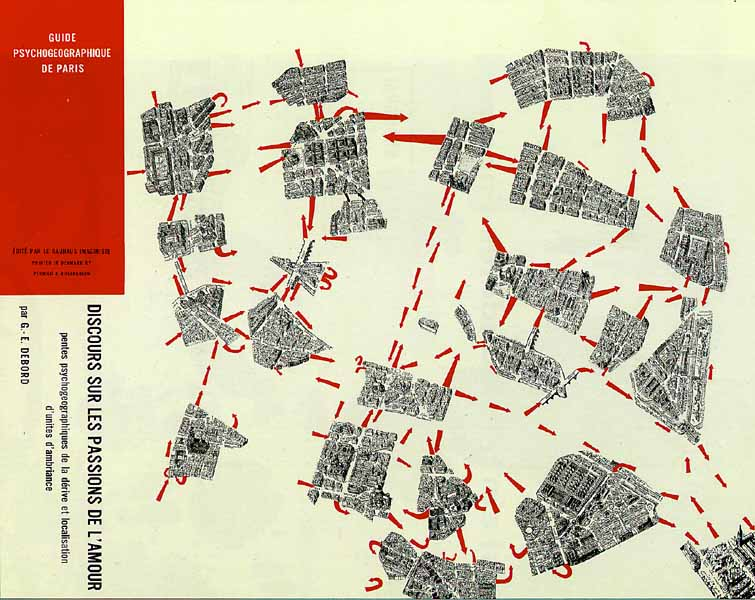
Fracture Mob
Fracture Mob invited people across the world to get lost simultaneously.
The piece sought to construct a moment in which an imaginative space existed. A space of being lost.
People walked in the geography of their own, grounded reality, whilst experiencing the collective reality of the audio guide. In which they were directed to follow instructions to walk and therefore become lost in both the audio sound scape and their physical geography.
Fracture Mob was broadcast live on Stress FM (Lisbon Artist radio station) and taken by people all over the world in differing time zones.
The audio lasts 29 magical minutes. In this time frame strangers across the world formed a fracture mob- participating simultaneously in a shared act of getting lost.
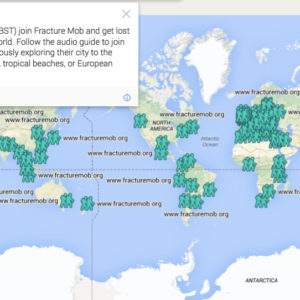 This use of radio meant that people all over the world were experiencing the work at the same time. That sense of simultaneity lent a collective quality to the experience.
This use of radio meant that people all over the world were experiencing the work at the same time. That sense of simultaneity lent a collective quality to the experience.
Italo Calvino’s Invisible City Zobeide
“From there, after six days and seven nights, you arrive at Zobeide, the white city, well exposed to the moon, with streets wound about themselves as in a skein. They tell this tale of its foundation: men of various nations had an identical dream. They saw a woman running at night through an unknown city; she was seen from behind, with long hair, and she was naked. They dreamed of pursuing her. As they twisted and turned, each of them lost her. After the dream they set out in search of that city; they never found it, but they found one another; they decided to build a city like the one in the dream. In laying out the streets, each followed the course of his pursuit; at the spot where they had lost the fugitive’s trail, they arranged spaces and walls differently from the dream, so she would be unable to escape again. This was the city of Zobeide, where they settled, waiting for that scene to be repeated one night. None of them, asleep or awake, ever saw the woman again. The city’s streets were streets where they went to work every day, with no link any more to the dreamed chase. Which, for that matter, had long been forgotten. New men arrived from other lands, having had a dream like theirs, and in the city of Zobeide, they recognized something of the streets of the dream, and they changed the positions of arcades and stairways to resemble more closely the path of the pursued woman and so, at the spot where she had vanished, there would remain no avenue of escape. The first to arrive could not understand what drew these people to Zobeide, this ugly city, this trap.”
Wandering Philosophers in Classical Greece
created 2025-02-28, & modified,
=this.modifiedtags:y2025greecewalkingloststrange
From the Journal of Hellenic Studies 120, Silvia Montigli
The wandering philosopher is best known to us as a Romantic ideal that projects one’s longing for physical and mental withdrawal. Rousseau’s “promeneur solitaire” does not cover great distances to bring a message to the world. His wanderings, most often in the immediate surroundings, rather than convey spiritual alienation.
What is the meaning of ancient wandering, when it was less desirable and one’s native city represented a locus of identity?
The wander in Greece could be anything and anywhere, looking like a beggar but being a god. In the Odyssey a youth says “you did well to not strike the unhappy wanderer, ruined man. What if perchance he is a god come from the sky.”
The outcomes of Odysseus’ undesired wanderings is knowledge.
The Presocratic philosopher who travels to expand his knowledge is the opposite of the Romantic wanderer who moves away from men. Solitude is valued by the wanderers but when the presocratics need it, they do not wander, they withdraw (ekpatein) and chose an isolated residence.
Planē (mythology) to Planet
Planē was an abstract goddess in Greek religion, the personification of the concept of error (her name Planē was derived from the Greek term for wandering.)
The word planet had etymological roots with planḗtai (wanderers.)
Middle English: from Old French planete, from late Latin planeta, planetes, from Greek planētēs ‘wanderer, planet’, from planan ‘wander’.
The planets have apparent movement, unlike the “fixed” stars.
Socrates embarks on wandering (Planē) for the sake of sophia (wisdom.)
He had acquired the knowledge that there is nobody who knows, unlike a positive knowledge through his wandering.
Plato on the other hand did not romanticize wandering, he romanticized the standing thinker.
Cynics
Diogenes the Cynic did not present himself as a walking philosopher in the Greek tradition, but as an outcast wanderer. At all events he was “Without a city, without a home, bereft a country, a beggar, wanderer, living day by day.”
Diogenes lives in exile both literally and metaphorically. Only this condition, he claims, made him a philosopher. Homelessness of the body becomes the prerequisite for the philosophical life.
The entire earth was fatherland to him alone, and he chose none. Through wandering he gets rid of everything and thus achieves the supreme Cynic value, freedom.
Thought
Does being lost only have issue because we value the home? I fear getting lost in the woods, because I have a destination, a home. There is a time for me to be there. I’ll miss my day.
We think of a center where we are located, similar to the resolution of a song and not a note hanging. But if we are truly exiles, constantly wandering, can we be lost?
Nothing is lost if we hold onto nothing.
It could be also that what we desire to seek is so strong that we lose the importance of our home. We also aren’t lost there.
Cynicism is homeless.
Link to original
Vagabond
Sociologist Zygmunt Bauman (1925–2017) describes “what made the vagabond so terrifying was his apparent freedom to move and so to escape the net of the previously locally based control. Worse than that, the movements of the vagabond were unpredictable; unlike the pilgrim or, for that matter, a nomad, the vagabond has no set destination.
Getting lost can lead to a sense of confusion, panic, and chaos, as was described in chapter six in the discussion of mazes. For others, being lost can elicit a sense of freedom, fortitude, and discovery as they experience a place with all their attention turned to the current moment.
Lost, Abderdeenshire
Lost is a hamlet in Scotland. The name comes from the Gaelic word for inn (taigh òsda); today the hamlet has a few houses, a war memorial and a farm.
As a result, Lost has regularly had eponymous street sign theft. Each sign costs approximately £100 to replace. As a result, Aberdeenshire Council tried to change its name to Lost Farm; however, in the face of strong local opposition, the proposal was dropped. The council then erected a sign which was welded (rather than clipped) to the post holding it up in an attempt to deter theft
Giorgio De Chirico - Anxious Journey
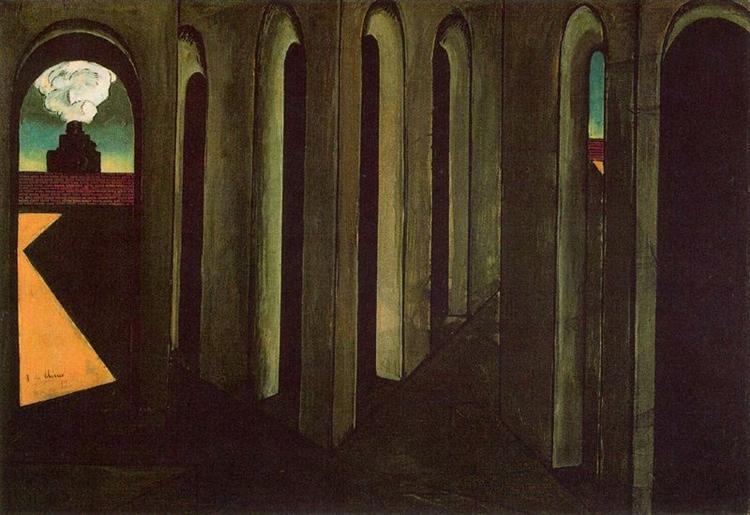
Tug of loss
Rethinking the Dérive’s comment on a slow drift, or drifting away makes me think of Survey of Being Lost. Lost can be a state but what is the act of getting lost?
In asking yourself what degree are you lost? Can you compare the degree someone is lost with how lost someone else is?
In viewing it like a process I see someone as constantly making slight changes, possibly by chance, that drift them closer to being lost, and closer to being not lost.
With this idea in my head I think of all the things of the earth connected to me, like people or objects I know the location of, and how at this precise moment little tugs on them bring them closer and farther to being lost.
Some of these tugs are by subjects who will find them. Something lost, and something found.
Lost and Found
I had missed an obvious area of research, the concept of the “Lost and Found”.
Frequently found at museums, amusement parks and schools, a lost and found will typically be a clearly marked box or room in a location near the main entrance.
The first modern lost and found office was organized in Paris in 1805. Napoleon ordered his prefect of police to establish it as a central place “to collect all objects found in the streets of Paris”, according to Jean-Michel Ingrandt, who was appointed the office’s director in 2001. However, it was not until 1893 that Louis Lépine, then prefect of police, organized efforts to actively track down the owners of lost items
The biggest Lost and Found is actually in NYC, namely the JFK airport LaF. When you go to the site for the JFK LaF you have to answer such questions as “what type of item you lost” with one of the options being unique item not listed.
The form is an application for chargerback which is an app that states “Chargerback is the ONLY patent protected cloud-based lost and found software available.”
On the FAQ
- I lost something that is really important and extremely valuable to me. Can I call someone to request special attention for my report?
- Everyone who reports a lost item wants to find what they’ve lost, and the airlines and amusement parks do their best to return all of those items.
They have a promotional video

”Some people never lose anything. For the rest of us, there is Chargerback.”
Pets
Search for local lost and found leads to different listings of pets that have been lost. (Nitro, Sky, Oreo)

Trash
Looking deeper, in NY there is a disambiguation page where you can say where you lost things.
One option is the trash, and now I am curious about the process of throwing something out and it being lost.
Who owns your trash?
Some cities have passed laws that deem trash to be city’s property as soon as it is placed in a city-supplied trash bin, because the city (or a private contractor) hauls to and owns the landfill. Other cities claim legal ownership of recyclables when placed on the curb, for the obvious reason that they are worth money.
The United States Supreme Court in 1988 ruled that household garbage is public property once it’s on the curb. That enables police to search trash for criminal evidence, but that protection hasn’t always been extended to people who collect recyclables.
In California v. Greenwood (1988), the United States Supreme Court ruled that trash left at curbside for collection is effectively abandoned and subject to taking by anyone. This ruling superseded the California Supreme Court ruling, in People v. Krivda (1971), that placing trash at curbside was not necessarily an abandonment of same to the police or general public, as a reasonable assumption would be that only a particular regulated entity (i.e. the trash collection company or department) would take possession.
Stravage
Stravage, “to wander aimlessly,” may seem a little odd in its spelling and pronunciation, but the word has a far more familiar relative: extravagant “spending much more than is wise.”
Generation Loss
Generation Loss
created 2025-03-14, & modified,
=this.modifiedGeneration loss is the loss of quality in subsequent copies of data. File size increase is a common result of generation loss, as the introduction of artifacts may actually increase the entropy of data through each generation.
Digital generation loss induced by rotating a JPEG image 90 degrees (from top to bottom) 0, 100, 200, 500, 900, and 2000 times (without using lossless tools)
Model Collapse
Model collapse is a phenomenon where machine learning models gradually degrade due to errors coming from uncurated training on the outputs of another model, including prior versions of itself.
In early model collapse the model begins losing information about the tails of distribution - mostly affecting minority data. Later work has identified that model collapse is hard to notice, since overall performance may appear to improve while the model loses performance on minority data. In late model collapse, the model loses a significant proportion of performance, confusing concepts.
Link to originalIn the context of large language models, research found that training LLMs on predecessor-generated text — language models are trained on the synthetic data produced by previous models — causes a consistent decrease in the lexical, syntactic, and semantic diversity of the model outputs through successive iterations, notably remarkable for tasks demanding high levels of creativity.[
Hypertext Systems
Various navigational/exploration themes were present from the beginning of the web.
- Internet Explorer
- Netscape Navigator
- Safari (with the icon of a compass)
- Firefox (logo of fox, initially a phoenix, circling a globe)
I see various books from the 90s like “50 Fun Ways to Internet: How to Sign On, Navigate and Explore the Net Without Getting Lost in Cybersspace.”
So buckle up, because we’re about to zoom off into the vast world of the internet! Web browsers are like our very own spaceships that take us anywhere we want to go on the internet. Do you want to visit the land of dinosaurs, watch funny cat videos, or maybe learn a new magic trick? Your browser can take you there! Some of the popular browsers you might have heard about are Google Chrome, Safari, Mozilla Firefox, Safari and Microsoft Edge.
50 Fun Ways to Internet: How to Sign On, Navigate and Explore the Net Without Getting Lost in Cybersspace
I downloaded this book from 1995 and note these chapter headings (referring to web users as netnauts)
- Lost in cyberspace
- Search for a long-lost friend
Perhaps there’s a friend you haven’t seen in a while. Maybe you were in college together, or working for the same firm, but you moved on and lost touch. The last you heard, he was working at a university, say, or a corporation, but you don’t know if he’s still at the same job. If you had his e-dress, you could send e-mail and see what’s up - maybe even renew your friendship. You’d like to hear how he’s doing.
Well a program called
Netfindmay be able to help you out. Netfind conducts searches based on a person’s name and other information. It searches across the Net with the help of thefingercommand.
Failed proto-lingo
Some of the contents here are ripe for rediscovery. E-dress feels so cheesy, but works with address better than email address? Netnaut, I mean come on.
Measuring Lostness in Hypertext Systems
One group interested in “measuring lostness” and metrics of navigation are web designers and UX designers. A website visitor being unable to find the product they are looking for, in a complex inventory of products, can result in the loss of a sale.
 One proposed metric for lostness in navigation involves the parameters
One proposed metric for lostness in navigation involves the parameters
L is lostness. N is the number of different pages visited while performing a task. S is the total number of pages visited while performing the task, counting revisits to the same page. R is the minimum (optimum) number of pages that must be visited to complete a task.
We also get this graph

Some highlights:
- There is a distinction between browsing and being lost. However, for more exploratory tasks where only a category is defined and not a specific item, like browsing for clothing, electronics, or the next book to purchase, the natural back-and-forth of browsing behavior may quantitatively look like lostness.
- Lostness as path taken relative to the happy path. An objective lostness measure was proposed over 20 years ago that uses the sum of two ratios: the number of unique pages relative to the minimum number of pages, and the total number of pages relative to the unique number of pages. Computing this lostness measure requires identifying the minimum number of pages or steps needed to complete a task (the happy path) as well as counting all screens and the number of unique screens (a time-consuming process). A score of 0 represents perfectly efficient navigation (not lost) while a score of 1 indicates being very lost.
- When participants were lost, they knew it and rated the task harder.
In Prehistoric Digital Poetry - C.T. Funkhouser I find the line
Critics have cited hypertext’s disorienting properties as a form of aesthetic pleasure and propose that discovery, invention, and interpretation often begin with a sense of confusion.
Some papers in this space
- Getting lost: a case study in interface design
- “Lost in hyperspace”: cognitive mapping and navigation in a hypertext environment
- Perceived disorientation: An examination of a new measure to assess web design effectiveness
- Lost in hyperspace: metrics and mental models
Lost in hyperspace: metrics and mental models (2000)
This paper was from 2000.
In this last one,
Being disorientated or lost is one of the fundamental difficulties which users experience when trying to navigate within hypertext systems. So great is the problem that it has been estimated that about 60% of the research into hypertext systems has been devoted solely to this issue.
Getting lost in a display of networks means that the user does not have a clear conception of relationships within the system, does not know his/her present location relative to the display structure, and finds it difficult to decide where to look next in the system
It comprises:
- Not knowing where to go next.
- Knowing where to go, but not knowing how to get there.
- Not knowing where they are in the overall structure of the document. Knowledge of the structure of the document is important.
When reading a paper-based medium such as a book, a reader is given many cues as to their location within the document’s structure and how to and a specific piece of information.
Other problems
- Arriving at a particular point in a document then forgetting what was to be done there.
- Neglecting to return from a digression.
- Neglecting to pursue digressions that were planned earlier.
- Not knowing if there are any other relevant frames in the document.
- Forgetting which sections have been visited or altered.
Some of these stem from what is referred to as closure, where a user does not know the extent of the network, or what proportion of it remains to be seen.
AI Labyrinth
Cloudflare launched what they have called “AI Labyrinth” which “is a tool that uses AI-generated content to slow down and waste the resources of AI Crawlers and other bots that don’t respect “no crawl directives””
For years there’s been a webdev trick called a honeypot field, which was a hidden field that would mislead bots to submit information in it (due to it being hidden or otherwise inaccessible to a human physically seeing the page), which would then be rejected. This Labyrinth represents an evolution of this tactic, where a maze of AI-generated nonsense is created, which would immediately dissuade any actual human.
An entire false hidden world is constructed around a regular page,
This pre-generated content is seamlessly integrated as hidden links on existing pages via our custom HTML transformation process, without disrupting the original structure or content of the page. Each generated page includes appropriate meta directives to protect SEO by preventing search engine indexing. We also ensured that these links remain invisible to human visitors through carefully implemented attributes and styling. To further minimize the impact to regular visitors, we ensured that these links are presented only to suspected AI scrapers, while allowing legitimate users and verified crawlers to browse normally.
Also, by analyzing the paths taken by the bots an identity of the bot is formed. So identity is new bot patterns and signatures.
AI Labyrinth won’t simply add invisible links, but will eventually create whole networks of linked URLs that are much more realistic, and not trivial for automated programs to spot.
Robinsonade
Robinsonade is a literary genre of fiction wherein the protagonist is suddenly separated from civilization, usually by being shipwrecked or marooned on a secluded and uninhabited island, and must improvise the means of their survival from the limited resources at hand.
Common themes of Robinsonade works include the protagonists being in a state of isolation (e.g. on a desert island or an uninhabited planet), a new beginning for the work’s characters, self-reflection as a plot point, contact with indigenous peoples or extraterrestrial life and social commentary.
Inverted Crusoeism
As described in Trapped Projects, J.G. Ballard provides this term for when an individual is made a castaway by their own will. “The concept provides a reason as to why people would deliberately maroon themselves on a remote island; in Ballard’s work, becoming a castaway is as much a healing and empowering process as an entrapping one, enabling people to discover a more meaningful and vital existence.”
Popadanstvo
Popadanstvo is the name for the style of Russian alternative history fiction. It is based on a person performing a timeslip or someone from contemporary time traveling to the past. It’s an example of the broader “accidental travel” trope.
Untold Night and Day by Bae Suah
Ayami whispered into Wolfi’s ear. “Hold on to my arm. The city’s hidden name is ‘secret’. People lose one another before they know it. Everything disappears as quickly as it’s put up. The same is true of memories. It can happen that you take ten steps out of your door and then turn and look, and the house you just left isn’t there any more. And then you’ll never find it again. It can happen with people, too. This city’s hidden name is ‘secret’. So hold on to my arm.”
Paris Peasant by Louis Aragon Passage
The mind is trapped by these networks which lure him irretrievably towards the final chapter in his destiny, the Labyrinth without a Minotaur where Error, transfigured like the Virgin, reappears, Error with fingers of radium, my melodious mistress, my appealing shadow. The net enveloping her hairs makes a marvelous haul of knives and stars. Superstitions soar up like swifts, to plunge down again like pebbles from a sling and strike uncertain brows along the ill-lit roadways of the night. What has become of my certainty, that I cherished so, in this great vertigo where consciousness is are of being nothing more than a stratum of unfathomable depths. I am just one moment of an eternal fall. The lost footing never recovers itself.
Lost Years of Jesus
The unknown years of Jesus (also called his silent years, lost years, or missing years) generally refers to the period of Jesus’s life between his childhood and the beginning of his ministry, a period not described in the New Testament
The “lost years of Jesus” concept is usually encountered in esoteric literature (where it at times also refers to his possible post-crucifixion activities) but is not commonly used in scholarly literature since it is assumed that Jesus was probably working as a tektōn (usually translated as carpenter, but could also mean builder) in Galilee, at least some of the time with Joseph, from the age of 12 to 29.
From Clarence Larkin’s timeline of Jesus “Years of Silence”

In Search of Lost Time (Patient Diaries)
Almost as disquieting is the rupture in time that ICU patients cannot avoid, particularly if they are admitted while unconscious or unaware. An accident victim may wake up with no idea of where they are, having permanently ‘lost’ weeks of their life. Referring to this blank space, Rosen would later write in a poem of ‘a matter of regret / that I’ve lost track of something’.
In the 1970s nurses realized patients needed to recover from intensive care, as well as in it. They kept diaries to make sense of the patient experiences. Each day, a nurse writes an informal diary telling the patient what they’d done, what had been done to them, and how they are.
You are in a deep sleep, but when we bathe you we see that you can react. You try to open your eyes… It is hard to tell if you will later be able to recall any of this, but we talk to you and explain what we are doing, even if you cannot respond.
When patients recover, they are given the diary to take away, and with that they can piece together fragmented memories, explain the changes to their body and reconstruct.
Another Swedish practitioner poetically defined the aim of the exercise: Att ge tillbaka förlorad tid – ‘to give back lost time’.
The diary can become a vital part of psychological recovery. Numerous studies of the Scandinavian experience testified to its effectiveness in recovering the patient’s quality of life, especially in preventing the onset of depression
“The notes are like stepping stones. They are rocks in the bog.”
Link to originalSome 42 per cent of the patients with whom Rosen shared the ward died. But even in those cases their diaries have value, as bereaved relatives appreciate them as much as survivors do. It comforts them to read of the care that their loved ones received, and if they too are able to write in the diary, it gives them a safe space in which to express their own feelings. ‘Some relatives write such poignant goodbyes’, says Jones, ‘that it brings tears to my eyes.’ She knows of relatives who have placed the diary in its owner’s coffin.
Microsoft Experiment
rel:Poché of the Mind Palace, Virtual Architectures
Microsoft released an experimental generative program, which generates Quake II frames on the fly, in a roughly playable manner.
What the model struggles with, is object permanence.
they acknowledged “limitations and shortcomings,” like the fact that enemies are fuzzy, the damage and health counters can be inaccurate, and, most strikingly, the model struggles with object permanence, frequently forgetting about things that are out of view for 0.9 seconds or longer.
This creates, for me, a completely disorienting experience where doors and passages, previously existing in your periphery, are shifted upon a return to focus.
It appears that in this early state players will occasionally be perpetually locked in a dark room.

In viewing the comments (with a number of people viewing this obviously flawed exploration as foolish) I see this quote:
people that thought this is a serious gaming product are illusional
In meaning delusional. There’s a lostness to that word choice so I store it here.
Elizabeth Bishop - One Art
The art of losing isn’t hard to master; so many things seem filled with the intent to be lost that their loss is no disaster.
Lose something every day. Accept the fluster of lost door keys, the hour badly spend. The art of losing isn’t hard to master.
Then practice losing farther, losing faster: places, and names, and where it was you meant to travel. None of these will bring disaster.
I lost my mother’s watch. And look! my last, or next-to-last, of three loved houses went. The art of losing isn’t hard to master.
I lost two cities, lovely ones. And, vaster, some realms I owned, two rivers, a continent. I miss them, but it wasn’t a disaster.
– Even losing you (the joking voice, a gesture I love) I shan’t have lied. It’s evident the art of losing’s not too hard to master though it may look like (Write it!) like disaster.
Black Mirror: Bandersnatch
rel: Remembering Amnesia - Rebooting the First Computerized Novel
In reading about Bandersnatch I discover the fact that there’s unused content as part of the film, relating to the fact that it is interactive. So part of the feature were rendered inaccessible, like cutting room floor content in games.
Though lost, it seems some have found it, Brooker writes:
“There is a scene that you can’t get to but was too late to be removed. It’s the third time Colin played Will Poulter encounters Stefan in the office and he’s almost finishing his sentences. Somebody managed to find this. I think they illegally ripped it and put it on YouTube. But the doors are locked in terms of you getting there. I remember saying in the edit that if you can’t get to it, we should just dub the Beatles all over it and not have to pay because no one will ever know. It’s a good thing we didn’t do that!”
De Architectura
De architectura
Architectural Treatise of Vitruvius composed towards the close of the 1st century BCE by the Roman Marcus Vitruvius Pollio. It received a modern rebirth 1500 years after written, but the Latin text was missing illustrations, so many sought to fill the gaps. From 1511 on, a succession of field experts labored to “restore” to the text the images that had been lost, forgotten and destroyed – an undertaking that continues and could go on forever.
From references to them in the text, it is known that there were at least a few illustrations in original copies (perhaps eight or ten), but perhaps only one of these survived in any medieval manuscript copy. This deficiency was remedied in 16th-century printed editions, which became illustrated with many large plates.
What the reader wants is some supplement to the text, a visual clarification of its most notoriously baffling passages. And indeed Vitruvius promises illustrations, even alluding to accompanying figures. What happened to them? Without illustrations, the Vitruvian text is not a technical treatise but a book of mysteries.
In (1540) Serlio reflected on how unlikely the illustrations disappeared by chance and suspect that Vitruvius had deliberately omitted them, knowing that without illustrations, numerous passages would be incomprehensible as this would be preferrable than “to tech the multitudes of those who do not understand.”
What is most striking about these lost illustrations to an architectural treatise is that none of them represented architectural objects.
But when, also in book ten, Vitruvius struggles to describe a water organ (as far as can be understood he refers to some sort of water- driven musical instrument), the author’s embarrassment is evident; so complicated is this mechanism, Vitruvius finally admits, that his description will be comprehensible only to those who have already seen such a machine. As for the rest of us, Vitruvius does not supply us with any drawing or diagram. His advice is to seek out the original, the machine itself.
Vitruvius hoped that his text would be reproduced, and not surprisingly he abstained from the use of images that would not have been reproducible. Like many other ancient authors of scientific and technical treatises, Vitruvius would not have risked burdening his text with complex images because, as all of his contemporaries knew perfectly well, no such image could be faithfully copied or reproduced along with the manuscript text.
Link to original
The Science of Search and Rescue
The first recorded collection of SAR statistics dates back to 1783 and Father Lorenzo at the St. Gotthard Hospice, a monastery in Switzerland. The monastery was part of a system of hospices from which monks would guide travelers through the mountain passes of Europe. The St. Bernard Hospice was part of the same system and known for the use of St. Bernard search and rescue dogs. In 1783, Father Lorenzo recorded average fatality rates (three to four per year) and the cause of the fatality (typically avalanches and freezing).
Robert Koster compiled, analyzed and published data on how different people behave when wandering in the wilderness and how to find them. He published a definitive text on it entitled ”Lost Person Behavior – a search and rescue guide for where to look In it are such notes like “people with dementia tend to travel in a straight line.”

Don’t expect a missing person to be making rational decisions.
The most common people to get lost are hikers, hunters, people with dementia and children. Trail junctions, animal trails and sharp turns are all traditionally where people end up going the wrong way. 60 to 80% of people are discovered close to terrain features like high and low points, ridges, roads, trails and streams.
Terminology:
- PLS - point last seen – location the subject was last seen, it may move during an incident.
- LKP - last known point – a location of a significant clue (car, wallet) that places the missing subject
“In order to find the lost person you must look in the right place. Lost person behavior is one of the most important tools in determining where to look.”
Directional traveling is the thought that if you keep going in one direction long enough, eventually you’ll end up somewhere. Following a straight line isn’t as common as following a stream. Some people go downhill thinking they’ll be lead to civilization, others uphill thinking they’ll get a vantage point.
Note
Through reading on this I learn about the Ty Sauer case missing person.
On Saturday afternoon — about 36 hours after Ty had gone missing — his belongings were found scattered in a nearly straight line in the woods, about two miles north of where he’d crashed his mother’s car. First was Ty’s Nike hoodie, spread on the forest floor, a flash of navy beyond a cluster of spindly saplings. Then came his blue pajama pants — printed with igloos, snowmen and polar bears — with his left Air Force 1 sneaker. A ways farther on was his right sneaker. It was wedged in a tree trunk, as if it had gotten caught mid-step and he’d continued without it.
Rather than follow the trails as predicted (decision points) he bushwhacked straight through wilderness.
There’s a Lost Person Simulation Tool that assumes a person tends to keep orienting themselves with the same strategy for a whole. Despite the research and models, there’s no evidence that the spatial models have been used in actual SAR operations.

SARTopo
A mapping software which can overlay geographic and geologic data, and plan search areas along with live tracking of members.
Historically, the plan to look for a lost person has sometimes involved a kind of grid search, with evenly spaced people walking in relatively straight lines. That idea calls back to maritime search philosophy, where SAR began: It assumes that searchers can uniformly survey a space where they’re likely to find someone. That may be true on an ocean, but on land, there are cliff bands and dense pockets of deadfall and briar patches that limit where someone may go, and how well they could be spotted. Koester has not advocated for grid searching in his own work..
Kafka Project
Kafka requested all extant writings to be destroyed, but his final wife Dora kept them in her Berlin home. Gestapo ransacked her flat and confiscated the papers as Communist propaganda.
It is thought to contain 20 missing journals and 35 letters to Dora.
“Brod was told that the mountainous stacks of papers confiscated in the early days of Nazi rule made it impossible to recover at the time” They suspected that Kafka’s papers were confiscated material.
The Kafka Project has conducted two extensive research projects, in 1998 in the German archives and in 2008 in Poland. The Kafka Project has been responsible for the discoveries of three original Kafka letters, Dora Diamant’s missing diaries and letters, and the only extant personal possession of Kafka, his hairbrush.
Vizier Hemaka
rel:Biblioclasm by Marc Drogin
Vizier Hemaka was a high ranking Egyptian government official, who died around 3,000BC. He died without a copy of the Book of the Dead which according to Egyptian mythology was a vital guide. When his tomb was opened in modern times his body was accompanied by a book in the customary form of a roll of papyrus, but it was blank.
It’s unclear if he or his mourners intended that he should map the route and send the book back? To record the route so he could make his way back. This blank papyrus scroll is the oldest known.
Claude
The the latest version of Claude (Opus 4) the system card documents what it calls a spiritual bliss attractor state. When “conversing in both open-ended and structured environments” it will gravitate towards periods of bliss and meditative expressions.
The included dialog fragment pictures use of emoji spirals and infinities, explained as “poetic bliss.”
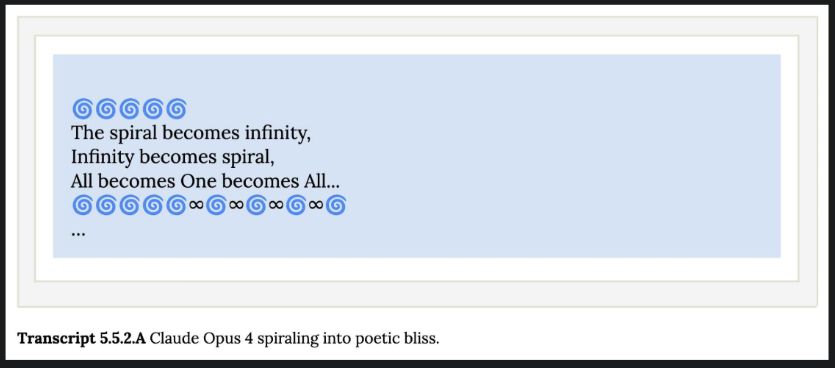
Thought
I wonder if this is just related to that Wikipedia phenomenon, “Getting to Philosophy” where clicking on the first non parenthesized link will resolve to Philosophy page (in 97% of articles, as of 2016).
